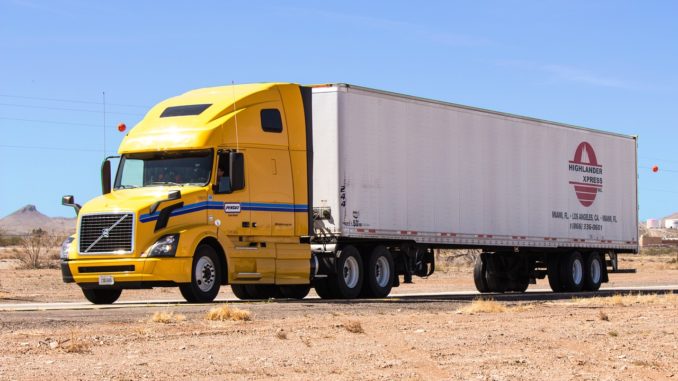
Truck driver wages depend on a number of factors. For example, let’s take a look at how region affects your pay.
A trucking company may pay differently depending on the region where the company is based, the region where the freight will be loaded, and the region where that freight is going. Weather and challenging terrain in different regions can also change your wages and how easy your trip will be.
Other factors that affect how truck drivers are paid include:
- The type of freight
- The type of truck or trailer (refrigerated vs flatbed, for example)
- Whether the trip is local or regional
- Whether driver’s path is the same dedicated route
- The size of the trucking company
- If the company offers bonuses for safety, fuel, idle time, violation-free inspections, or other incentives
- If the truck driver is an owner-operator or company driver
Are Truck Drivers Paid Per Mile or Hourly?
Local drivers are usually paid by the hour. Local drivers and dedicated route drivers average between $8.00 and $30.00 per hour. That’s pretty simple and easy.
For long-haul truck drivers, it gets a little more complicated.
Long-Haul Trucking Pay
Long-haul, or over-the-road (OTR), drivers get paid by the standards of “piecework,” which means a worker is only paid for what is produced. What truckers produce is miles. That means drivers are only paid when the wheels are moving.

OTR drivers can expect to make between 28 and 45 cents per mile. Cents per mile, or CPM, is a common way to calculate payment in the trucking business.
Only drivers with a proven track record of at least a year of dependability, safety, and a sparkling clean MVR (Motor Vehicle Report) should expect to receive between 40 and 45 cents per mile. The typical OTR driver runs 2,000-3,000 miles per week.
Some trucking companies simply pay a percentage of the load, usually 23-25%. If the company or owner of the truck is making $1.00 per mile that means you are making 23 CPM.
Percentage is mostly paid to owner-operators, however, and they can command a larger piece of the pie. Percentage-based pay can lead to more money when the freight is valuable, but this isn’t always something you can control.
What You Drive Is What You Make
When it comes to truck driving for a company that pays CPM, if the wheels are turning, you’re making money. This method of payment has worked well for the industry for a very long time, but it doesn’t allow for delays, like traffic backups, mechanical breakdowns, fueling or scaling the load, DOT mandatory breaks, DOT inspections, or even performing the required vehicle inspections.
The biggest point of frustration for drivers is that you don’t get paid while unloading your truck. That can mean a lot of waiting and unpaid time.
Live loads and unloads require the driver to actually bump the dock and sit around while being loaded or unloaded. Live loads or unloads can take anywhere from 30 minutes to 2 hours. If the freight is refrigerated (particularly with groceries), your wait may be even longer.
Occasionally trucking companies will pay drivers “detention pay” if you are waiting around at a shipper or receiver, but you can’t always expect this to be added to your regular truck driver wages.
The big takeaway for long-haul drivers is a simple equation: Miles = money.
How Are My Miles Calculated?
Cents per mile equals the number of miles you drive multiplied by the number of pennies. Seems pretty simple, right? Well, there are a number of ways miles are calculated.

As the Crow Flies
The shipper and the consignee are always looking for the easiest way to keep costs down, so sometimes they calculate their miles “As the Crow Flies.” This means the miles are measured as a straight line from point A to point B.
“As the Crow Flies” drastically reduces the amount of miles a truck driver is paid for because the driver can obviously not fly like a crow. Drivers must take winding roads, while their detours are not paid for.
Hub Miles
On the other hand, some companies calculate their miles by the “hub miles” measurement, which pays for every mile driven, even if the driver has to take a detour or if they miss an exit.
Hub miles is the method most in favor of the driver! As you can tell, the “how” of calculating miles can have a big impact on your paycheck.
Practical Miles and HHG
Most often, your miles are calculated by software like Rand McNally or PC Miler as either practical miles or HHG.
- Practical miles – This calculation determines miles on truck routes from the beginning to the end of a trip. Practical miles may not be the shortest route by miles, but it’s considered the fastest. This measurement reduces time spent on two-lane roads, four-lane roads, US Highways or state roads that include decreased speed limits, or paths that include: stop lights, pedestrian traffic, or slow-moving farm equipment.
- Household Goods (HHG) – Also known as “short miles,” HHG is the shortest route by road, from ZIP code to ZIP code. Unfortunately, HHG often does not take into consideration limitations, such as weight limits, low clearance on bridge, or no truck zones, that force you to detour. This means that the actual route traveled is often 5-15% longer than the HHG calculation. If a company pays by HHG, the truck driver will often do additional miles that go unpaid.
Other Considerations for Truck Driver Pay

Another factor for your pay is if a trucking company only pays “loaded miles,” which is only when the truck has freight on it.
That means any deadhead trips from the delivery point to the shipper to pick up a new load are unpaid.
Other companies use a sliding pay scale. Because drivers are paid per mile, shorter trips usually pay less.
As a result, some companies pay more per mile for shorter trips in order to encourage encourage drivers to accept these routes.
In team driving, drivers’ CPM is less, somewhere between 32 and 47 cents per mile because the miles are split evenly.
Team drivers compensate for lower pay by keeping the wheels turning 24/7. One person drives while the other sleeps, and then they swap.
There are a number of ways to calculate mileage, which can get kind of confusing. But if you treat each day like a work day and put in the mileage, then you can count on a weekly paycheck between $700 and $1300.
What Would Truck Driver Wages Look Like at an Hourly Rate?
Caution! Math ahead! How can a driver figure what they’re making per hour? The answer is acquired using an algebraic formula. Say the driver has just received a paycheck where the gross pay was $854.00 but his actual time at work, including all the downtime for inspections and paperwork, dock time, fueling and scaling was 67 hours. The set up of the problem to figure would look like this:
The formula is 40x + 1.5xy= Weekly Pay. X equals hourly pay, and Y is the amount of hours over 40.
The reason you have a separate factor for the hours over 40 is to account for overtime. Truck drivers are not normally paid for overtime, but in this equation, we are trying to figure out what it looks like if truck drivers were paid at a normal hourly rate. You have to factor in Y hours at 1.5 the pay because of overtime laws.
So when we plug in the fact that the driver worked 67 hours (which is 27 hours over 40) and made $854 for the week, we get the following equation:
40x + (1.5x times 27) = $854
Using the order of operations, solve the multiplication inside the parenthesis first
40x + 40.5x = 854
Now add up the like variables
80.5x = 854
In order to find out what x equals, divide each side of the equal sign by 80.5
80.5x divided by 80.5 equals x; 856 divided by 80.5 equals 10.633
x = 10.63
This equation show that the drivers hourly pay allowing for overtime after 40 hours would be $10.63 per hour.
